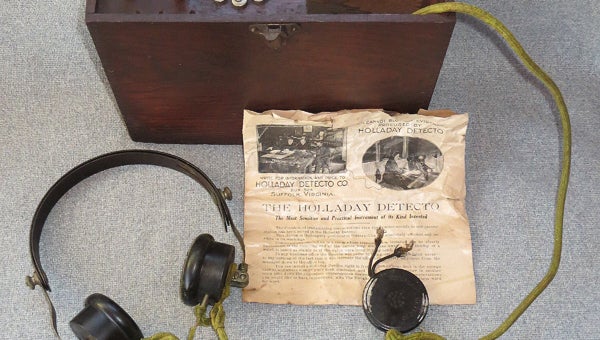History in a box
Published 11:17 pm Saturday, January 18, 2014

The Holladay Detecto Co. was located on Suffolk and produced this piece of equipment, which apparently is an old-fashioned listening device, or bug. Kermit Hobbs found it in an old box of “electrical junk” his father had brought home from Benthall Machine Co. in the 1950s. (Kermit Hobbs photo)
A bug in the attic
By Kermit Hobbs
One reason I enjoy Suffolk history so much is that I never know when a new bit of history might turn up. I recently stumbled upon something interesting in a place where I would never have expected it — right in my own attic.
Way back in the 1950s, when my dad was working at Benthall Machine Company here in Suffolk, I vaguely remember him bringing home a box of old electrical junk that was being thrown away. Most of it was frayed wires, old radio tubes and switches, and the like. Since I’m a junk collector, it ended up in my attic.
As I was digging through it, I found a wooden box with wires connected to it, obviously some kind of primitive electrical instrument. It contained old batteries, a coil of some kind, and what looked like part of an old-fashioned telephone. I also found a crumpled paper flyer that explained exactly what it was.
The device was a Holladay Detecto, manufactured by Holladay Detecto Co. of Suffolk.
The flyer describes the Detecto as “the most sensitive and practical instrument of its kind invented. You cannot blot out evidence procured by the Holladay Detecto.”
A photograph shows several men working at a desk, with a transmitter, actually a microphone, mounted discreetly to the desk. That photo is connected by a wavy line to another photo of a woman wearing headphones, obviously eavesdropping on the men’s conversation.
The Holladay Detecto was a “bug.”
The flyer includes testimonial letters from a number of satisfied customers, including the Department of Justice, Bureau of Investigation in Washington, D.C., and the Department of Police, in the city of Buffalo, N.Y.
Mr. N. R. Withers of the Cooper-Riddick Co. in Suffolk wrote, “Without solicitation on your part, we wish to compliment the wonderful machine which you have recently installed in our office for the detection of some … thieves who were taking grain from the warehouse.” The letters were dated 1914 and 1915.
The batteries that were in the unit were marked with an expiration date of 1948, indicating that it was still being used in the mid- to late 1940s.
Obviously, public ideas about ethics in eavesdropping were not as well developed then as they are today.
The device’s inventor and the owner of the Holladay Detecto Company was James E. B. Holladay of Suffolk. Holladay was mayor of Suffolk from 1911 to 1915. His office was on Main Street, at the approximate location of the Suffolk Towers building. He was listed in an early city directory as an attorney who lived on Linden Avenue.
So the question that remains is this: What would the Holladay Detecto have been used for at Benthall Machine Company?
The device could have been used for dictation of letters to a stenographer, of course, but that would seem rather awkward.
We do know for a fact that in the early 20th century there was stiff competition between manufacturers of peanut pickers, sometimes leading to patent infringement lawsuits. Could this device have been used to get insights into the competition’s ideas?
This is quite a stretch, of course. But speculation about “what might have been” is another fun part of studying local history.


